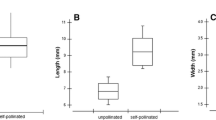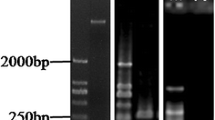Abstract
Understanding of fertilization procedures and crossing barriers is essential for various plant breeding methods. Growth or inhibition of pollen tubes, therefore, is a crucial issue in terms of propagation, in particular concerning the determination of self incompatible (SI-) plants. In German Chamomile, vegetatively propagated SI-plants would be a highly appreciated breeding tool for the formation of maternal lines for specific crossings. Following the idea to enhance knowledge of aspects of pollination and to develop a fast procedure of determination of SI-plants, two different methods of microscopic analysis of pollen tube growth in pistils were developed. Under light and under fluorescence microscopy diverse stages of pollen tube growth could be made visible. These included growth starts at the stigma, active pollen tubes with regular callose deposits on their way through the style and globular stage embryos in the ovary. Furthermore, SI-tests and selections within six accessions of German Chamomile and among 220 plants were carried out. In this case, self incompatibility (SI) was determined as staying seedless after multiple hand pollination under crispac bag isolation, observed at not less than three flower heads per plant. Diploid varieties showed a tendency to establish SI, rather than their tetraploid relatives, although a high variability between accessions was given. An overall accordance between SI, examined via seed set, and evidence of pollen tubes could not be assessed. Nevertheless, new and detailed insight in fertilization procedures in German chamomile could be gained.








Similar content being viewed by others
References
Albooghobaish N, Zarinkamar F (2012) Study of inflorescence development under lead toxicity in Matricaria chamomilla. Int Proc Chem Biol Environ Eng (IPCBEE) 33:253–258
Allard R (1999) Principles of plant breeding, 2nd edn. Wiley, New York
Anderson N, Ascher P, Widmer R, Luby J (1990) Rapid generation cycling of chrysanthemum using laboratory seed development and embryo rescue techniques. J Am Soc Hortic Sci 115(2):329–336
Andreucci A, Ciccarelli D, Pagni A Desideri I (2008) Glandular hairs and secretory ducts of Matricaria chamomilla (Asteraceae): morphology and histochemistry. Ann Bot Fenn 45(1):11–18
Atlagic J, Terzic S, Marjanovic-Jeromela A (2012) Staining and fluorescent microscopy methods for pollen viability determination in sunflower and other plant species. Ind Crops Prod 35:88–91
Ceter T, Pinar N, Inceer H, Hayirlioglu-Ayaz S, Yaprak A (2013) The comparative pollen morphology of genera Matricaria L. and Tripleurospermum Sch. Bip. (Asteraceae) in Turkey. Plant Syst Evol 299(5):959–977
Durka W (2002) Blüten—und Reproduktionsbiologie. In: Klotz S (ed) Schriftenreihe für Vegetationskunde. Bundesamt für Naturschutz, Bonn
Faehnrich B, Nemaz P, Franz C (2013) Self-incompatibility and male sterility in six Matricaria recutita varieties. J Appl Bot Food Qual 86:167–171
Funk V, Susanna A, Stuessy T, Bayer R (eds) (2009) Systematics, evolution and biogeography of compositae. International Association for Plant Taxonomy, Vienna
Gotelli M, Galati B, Medan D (2010) Structure of the stigma and style in sunflower (Helianthus annus L.). Biocell 34(3):133–138
Harling G (1951) Embryological studies in the compositae. Part II. Anthemidae-Chrysantheminae. Acts Horta Bergiani 16:2–56
Heine H, Eger H, Franz C, Blüthner W, Hoppe B (2009) Kap. 2.3 Sortenwesen. In: SALUPLANTA, Hrsg. Handbuch des Arznei- und Gewürzpflanzenanbaus, Band 1, Grundlagen des Arznei-und Gewürzpflanzenanbaus I. Bernburg: Verein für Arznei-und Gewürzpflanzen SALUPLANTA e.V, pp 609–640
Huang Y, Kao W (2014) Different breeding systems of three varieties of Bidens pilosa in Taiwan. Weed Res 54(2):162–168
Kearns C, Inouye D (1993) Techniques for pollination biologists. University Press of Colorado, Colorado
Lüttge U, Kluge M, Bauer G (1999) Botanik. 3. Auflage. Wiley-VCH, Weinheim, New York, Chichester, Brisbane, Singapore, Toronto
Musial K, Plachno B, Swiatek P, Marciniuk J (2013) Anatomy of ovary and ovule in dandelions (Taraxacum, Asteraceae). Protoplasma 250(3):715–722
Newcomb W (1973) The development of the embryo sac of sunflower Helianthus annuus L. before and after fertilization. Diss Abstr Int B 34(4):1403–1404
Odenbach W (ed) (1997) Biologische Grundlagen der Pflanzenzüchtung. Parey Buchverlag, Berlin
Plescher A, Sonnenschein M (2013) Schlussbericht 1: Züchtung einer Qualitätssorte von Kamille mit hoher Ertragsfähigkeit bei maschineller Ernte. www.fah-sinzig.de. Accessed 04 Jun 2014
Raina R, Bhandari S, Romesh C, Yashpal S (2013) Strategies to improve poor seed germination in Stevia rebaudiana, a low calorie sweetener. J Med Plants Res 7(24):1793–1799
Richards A (1997) Plant breeding systems, 2nd edn. Chapman & Hall, London
Schilcher H (1987) Die Kamille. Handbuch für Ärzte, Apotheker und andere Naturwissenschaftler. Wissenschaftliche Verlagsgesellschaft mbH, Stuttgart
Stahl-Biskup E, Reichling J (2010) Anatomie und Histologie der Samenpflanzen. Mikroskopisches Praktikum für Pharmazeuten. 3. Auflage. Deutscher Apotheker Verlag, Stuttgart
Stoskopf N, Tomes D, Christie B (1993) Plant breeding—theory and practice. Westview Press, Boulder, San Francisco, Oxford
Sukno S, Ruso J, Jan C, Melero-Vara J, Fernandez-Martinez J (1999) Interspecific hybridization between sunflower and wild perennial Helianthus species via embryo rescue. Euphytica 106(1):69–78
Vetter S, Franz Ch (1998) Samenbildung bei Kreuzungen und Selbstungen mit polyploiden Achillea-Arten (Asteraceae). Z Arznei Gewürzpflanzen 3:11–14
Yanming D, Nianjun T, Sumei C, Fadi C, Zhiyong G, Aiping S, Qingshan C (2010) Reproductive barriers in the intergeneric hybridization between Chrysanthemum grandiflorum (Ramat.) Kitam. and Ajania przewalskii Poljak. (Asteraceae). Euphytica 174(1):41–50
Acknowledgments
This work was supported by the Fachagentur Nachwachsender Rohstoffe (FNR) of the Federal Ministry of Food and Agriculture, Germany (BMELV) under Grant Number 22038911.
Author information
Authors and Affiliations
Corresponding author
Rights and permissions
About this article
Cite this article
Faehnrich, B., Kraxner, C., Kummer, S. et al. Pollen tube growth and self incompatibility in Matricaria recutita . Euphytica 206, 357–363 (2015). https://doi.org/10.1007/s10681-015-1478-0
Received:
Accepted:
Published:
Issue Date:
DOI: https://doi.org/10.1007/s10681-015-1478-0




